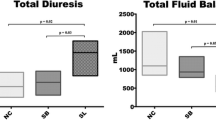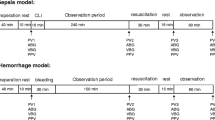Abstract
The most appropriate solution for volume replacement in hemorrhagic shock is controversial; however, hypertonic saline (HTS) solutions have recently gained widespread acceptance. In this study, various solutions were used to resuscitate rats in hemorrhagic shock, and their impact on the extent of bacterial translocation was investigated. Rats were bled to a mean arterial blood pressure of about 35 mmHg which was maintained for 30 min. They were then randomized into six groups. Blood pressure was found to be regulated by blood + lactated Ringer’s solution (LR) and HTS+LR, but no significant improvement was observed in the control and LR groups. Groups II (7.5% HTS+60 ml/kg LR) and IV (60 ml/kg LR + autologous blood) had a significantly better result than groups I (7.5% HTS), III (60 ml/kg LR), and IV (P<0.05), among which no statistically different results were seen (P>0.05). While no organisms were isolated from the mesenteric lymph nodes in the sham group, the rates of positive culture were 12.5%, 12.5%, 50%, 62.5%, and 62.5% in groups I, II, III, and the control group, respectively.Escherichia coli was the most commonly isolated organism. HTS+LR was demonstrated to be effective for decreasing the rate of early bacterial translocation to mesenteric lymph nodes and also for restoring the mean arterial pressure.
Similar content being viewed by others
References
Chuang JH, Shiel CS, Chang NK (1993) Role of parenteral nutrition in preventing malnutrition and decreasing bacterial translocation to liver in obstructive jaundice. World J Surg 17:580–586
Alexander JW, Boyce ST, Babcock GF, Gianotti L, Perk MD, Dunn LD, Pyles T, Childress CP, Ash KS (1990) The process of microbial translocation. Ann Surg 212:496–510
Deitch EA (1990) Gut failure: its role in the multiple organ failure syndrome. In: Deitch EA (ed) Multiple organ failure. Thieme, New York, pp 40–59
Dubic MA, Wade CE (1994) A review of the efficacy and safety of 7.5% NaCl, Dextran 70 in humans. J Trauma 36:323–330
Bark T, Katouli M, Ljungquist O, Möllby R, Svenberg T (1995) Glutamine supplementation does not prevent bacterial translocation after non-lethal hemorrhage in rats. Eur J Surg 161:3–8
Berg RD, Garlington AW (1992) Translocation of certain indigenous bacteria from the gastrointestinal tract to the mesenteric lymph nodes and other organs in a gnotobiotic mouse model. Infect Immun 23:403–411
Patel A, Kaleya RN, Sammartano RJ (1992) Pathophysiology of mesenteric ischemia. Surg Clin North Am 72:31–41
Spaeth G, Berg RD, Specian RD (1990) Food without fiber promotes bacterial translocation from the gut. Surgery 108:240–247
Fry DE, Pearlstein L, Fulton RL (1980) Multiple system organ failure. Arch Surg 115:136
Morales J, Kibsey P, Thomas PD, Poznansky MJ, Hamilton SM (1992) The effect of ischemia and ischemia-reperfusion on bacterial translocation, lipid peroxidation and gut histology: studies on hemorrhagic in shock in pigs. J Trauma 33:221–222
Wilmore DW, Smith RJ, O’Dwyer ST, Jocobs DO, Zeigler TR, Wang XD (1988) The gut: a central organ after surgical stress. Surgery 104:917–923
Rush BF, Redan JA, Flanagan JJ, Henegan JB, Hsreh J, Murphy TF, Smith S, Machiedo CW (1989) Does the bacteriemia observed in hemorrhagic shock have clinical significance? A study in germ-free animals. Ann Surg 210:342–347
Reed LL, Manglono R, Martin M, Hochman M, Kocka F, Barrer J (1991) The effect of hypertonic saline resuscitation on bacterial translocation after hemorrhagic shock in rats. Surgery 110:685–688
Topaloğlu Ü, Yilmazcan A, Güloğlu R, Diren, S, Peker Ö, Ünalmi§er S (1998) The effects of hypertonic solutions on early resuscitation of severe hemorrhagic shock. Med Bull Istanbul, in press
Author information
Authors and Affiliations
Rights and permissions
About this article
Cite this article
Topaloğlu, Ü., Yilmazcan, A., Güloğlu, R. et al. Hypertonic saline prevents early bacterial translocation in hemorrhagic shock. Surg Today 29, 47–50 (1999). https://doi.org/10.1007/BF02482969
Received:
Accepted:
Issue Date:
DOI: https://doi.org/10.1007/BF02482969




